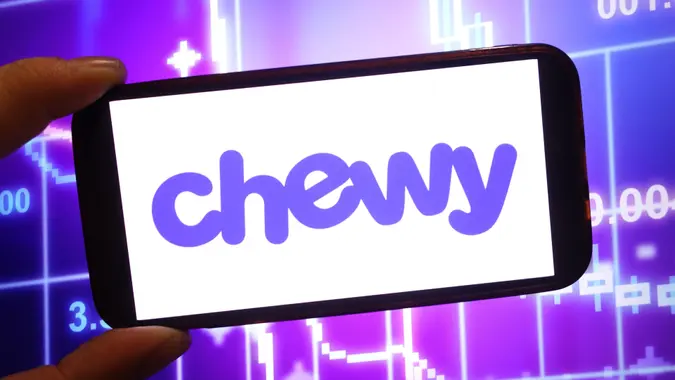How To Make Money With Options: Beginner-Friendly Strategies

Commitment to Our Readers
GOBankingRates' editorial team is committed to bringing you unbiased reviews and information. We use data-driven methodologies to evaluate financial products and services - our reviews and ratings are not influenced by advertisers. You can read more about our editorial guidelines and our products and services review methodology.

20 Years
Helping You Live Richer

Reviewed
by Experts

Trusted by
Millions of Readers
Options are a type of derivative, meaning they “derive” their value from the securities they’re linked to. Options are also leveraged, meaning a smaller amount invested in them generates larger gains — or losses — than simply buying the underlying security.
Here’s a deeper dive into how to make money with options trading and some ways of getting started.
Basics of Options Trading
If you think Tesla stock is about to make a huge move up, rather than laying out $20,000 or more to buy 100 shares of the stock, you can spend perhaps $200 per option to gain the same amount of exposure. These trades have very different risk profiles, but the capital needed reflects the leverage involved.
So, before you can successfully trade options, you’ll need to familiarize yourself with some basic terms.
Call Options
A call option gives you the right, but not the obligation, to buy a stock at a certain price before a specified date. For example, a call option with an expiration date of April 14 and a strike price of $500 gives you the right to buy 100 shares of Microsoft stock at $500 per share or $50,000 total, on or before its expiration date.
There are two components of option value: intrinsic value and time value.
Intrinsic Value
In this example, your Microsoft call option will have intrinsic value whenever the stock price trades above $500. So, if on expiration day, MSFT stock is at $525, your call option will have an intrinsic value of $25.
Time Value
Time also gives a call option value. The farther away its expiration date is, the greater the chance MSFT stock has to climb above its strike price of $500. So if you buy that call option in January, even if the stock is below $500, the option will have value, in the form of time value.
Call options are generally used to make bullish bets on stocks or the overall market, since they rise in value when the underlying stock or index gains as well.
Put Options
Put options are the polar opposite of call options. Put options give holders the right, but not the obligation, to sell a stock at a given price before a specified date. Using the above example, if you own a Microsoft put with a strike price of $500 and an expiration date of April 14, you can sell 100 shares of MSFT anytime before that date.
As put options work in mirror-image fashion to call options, the put option has intrinsic value whenever MSFT stock trades below $500 per share. It also has time value.
Put options can help protect your portfolio in a falling market. For example, if you have a big gain in Microsoft and don’t want to sell it, you can buy put options to protect your gains–even if you think that the market is about to go down. The options will gain value any time the stock declines.
Popular Strategies To Make Money with Options
In addition to simply buying calls and puts, there are several strategies that investors use to generate income, hedge portfolios, limit risk or even take on additional risk. Here are some of the most common:
Covered Calls
Selling covered calls is a more conservative option strategy that carries lower risk and reward.
When you sell a covered call, you’re selling a call against a stock you already own. This means you give another investor the right to buy, or “call,” your shares of stock away at a specific price and date. By selling away this right, you receive the option premium as income.
The ideal scenario for an investor is selling a call when the stock’s price stays below the option’s strike price. In that case, you keep both the premium as income and your stock.
In other words, if your stock falls, does nothing, or rises to a price below the stock price, you profit from the sale. But if the stock rises, you may lose out on some potential upside as your stock gets called away from you by the purchaser of the option. For this reason, if you want to keep the stock, you should only sell at a price that you’d be happy to receive.
An Example
Imagine you own 100 shares of Coca-Cola, which is currently trading at $70 per share. While you don’t want to sell the stock, you’d be fine accepting $80 per share for your position, as that would mark a 14% gain over current levels. You could sell a call option against your shares at the $80 strike price for a premium of, say, $2 per share.
If the stock stays below $80 until the option expires, you keep both the $200 in premium income and your 100 shares of Coca-Cola. If the stock rises above $80, your shares would likely be called away, and you’d receive $8,000 for the position, plus the $200 premium, netting a total of $8,200. In this sense, selling a covered call limits your upside, but still provides income. The trade-off is that if Coca-Cola rises well above $80, such as to $90 or higher, you’d miss out on those additional gains.
Cash-Secured Puts
Selling a cash-secured put, also known as a covered put, is a way to generate income from an existing short position. If the stock’s price doesn’t move or falls slightly, your profit boosts from the premium you receive for selling the put.
On the other hand, if the stock rises sharply, there’s some risk there. It will result in a loss. However, the loss will still be less than if you held the short position outright.
Vertical Spreads
A vertical spread is an options strategy that limits risk while allowing for profits on directional price movements. According to Charles Schwab, it involves buying and selling two of the same option types with different strike prices. For example, if you buy an MSFT call option with a strike price of $100 and sell one with a call price of $105, that is a vertical spread. Similarly, selling an MSFT put at $100 and buying one at $105 is also a type of vertical spread.
Vertical spreads can be either credit or debit and bullish or bearish.
Credit Spread
A credit spread involves selling an option for a higher premium than the one you buy. A debit spread involves selling an option for less than you pay to buy another option.
A bullish vertical spread profits when an underlying stock appreciates, while a bearish one profits from a market decline. For example, if you buy an MSFT call with a strike price of $400 and sell one with a strike of $450, you’ll profit when the stock rises between $400 and $450. This example doesn’t take into account the premiums received; however, the underlying concept is the same.
Advanced Options Strategies
As options can be complex investments, professional and expert investors often use them for more advanced strategies. Here are some common ones, with the caveat that you should fully understand the risk vs. reward profile of these strategies before you use them.
Iron Condors
These work in range-bound markets. This limited risk strategy involves combining two vertical spreads, according to Fidelity: a bear call spread and a bull put spread. The strategy “wins” when the underlying security doesn’t move much by the time it expires.
Straddles and Strangles
These work best during volatile markets, according to Fidelity. A long strangle, for example, involves buying a long call and a long put on the same security with the same expiration date but with different strike prices. A long straddle is the same except that the options also have the same strike price, not different ones as with a strangle. Either way, if the underlying security moves a great deal in a short period, you stand to earn a lot of money. No movement, however, could result in the loss of your entire investment.
LEAPS
Also known as “long-term equity anticipation securities,” LEAPS offer longer-term options trading, with expiration dates of up to three years, according to Fidelity. They give investors a much longer time than the typical option to benefit from security price movements, but they cost more due to their large time values.
Risks and Challenges in Options Trading
When it comes to using options, some strategies are conservative, with limited loss potential, while others could cost your whole bankroll. In some cases, such as selling a naked put, your theoretical loss is unlimited. This is why you should understand how options work before you make any trades, particularly the more aggressive sort.
Market volatility or an individual stock’s volatility has a direct impact on how options are priced. Relatively “boring,” slow-moving stocks like Procter & Gamble have smaller option premiums, while high-flyers like Nvidia can have very expensive options.
While options trading can be quite lucrative, it’s essential to bring a risk management strategy to your trading. Otherwise, you could be taking on extremely high levels of risk.
3 Tips for Beginners To Succeed in Options Trading
A beginner can get lost in the deep end of options trading quite quickly, especially with the promise of big gains. As the saying goes, however, you should learn to walk before you run. Here are some ways to learn the options game without sinking all of your money:
1. Start Simple
Writing covered calls is a good way to learn how options work without taking on too much risk. The worst-case scenario if you write covered calls is that someone buys your stock at a higher price. You don’t run the risk of losing any money, just missing out on any future appreciation in your stock.
2. Limit Risky Investments
If you blow your whole bankroll on the first day, you’re not likely to continue. Limiting potential losses keeps you in the game and gives you more time to learn how options work in a real-world setting.
3. Learn All You Can
You could spend the rest of your life learning about the options market and probably still not know every single thing about it. Start by learning to read options chains and understand “the Greeks,” which help you to understand risk and reward. According to Charles Schwab, the five main “options Greeks” are delta, gamma, theta, vega and rho.
How Options Trading Differs From Stock Trading
Although options trading may be related to stock trading, they are very different. When you buy a stock, you have an ownership share in a real company. You participate in its gains and losses until you decide to sell your shares to another investor.
An option is a derivative, meaning it’s just an artificial financial construct that derives its value from some other security. Options provide leverage, which amplifies both gains and losses. Options only exist for a specified period and expire worthless in many cases.
In short, stocks are perpetual investments that last as long as the underlying company does. Options are leveraged, time-limited investments, some of which offer high potential reward in exchange for high risk.
Final Take
Employing options trading strategies — and understanding the market — can make you a lot of money. There can also be a lot of risk involved. If you’re interested in trading options, it’s a good idea to consult a financial advisor about your risk tolerance and financial goals first. Start small and build your knowledge before you put too much of your income at risk.
Options FAQ
Here are the answers to some of the most frequently asked questions about options.- What is the best strategy for beginners to make money with options?
- Selling covered calls is the most conservative options strategy, as you'll receive income in the form of a premium. Your only downside is potentially having to give up the underlying shares to an investor at the option strike price. There's no risk of losing your entire investment.
- Can you lose more money than you invest in options trading?
- In some cases, yes, you can lose more money than you invest when trading options. For example, if you sell an uncovered call, your loss is theoretically unlimited. If the option strike price is, say, $10 per share, you'll have to sell shares to an investor at $10 even if you have to buy them and $900 or more in the open market.
- How much capital do I need to start trading options?
- There is technically no minimum capital requirement to trade options at a firm like Fidelity, although you will have to get approved for trading on margin. However, you should only trade options with money that you're comfortable losing.
- Are options a good way to hedge a stock portfolio?
- Selling covered calls or buying puts to hedge an existing portfolio can be very effective strategies. Both offer ways to make money if your portfolio value is falling.
Information is accurate as of March 28, 2025.
Our in-house research team and on-site financial experts work together to create content that’s accurate, impartial, and up to date. We fact-check every single statistic, quote and fact using trusted primary resources to make sure the information we provide is correct. You can learn more about GOBankingRates’ processes and standards in our editorial policy.
- Charles Schwab. 2023. "Bullish & Bearish Vertical Options Spreads."
- Fidelity. 2024. "The iron condor options strategy."
- Fidelity. 2024. "Taking advantage of volatility with options."
- Fidelity. 2024. "LEAPS and bounds."
 Written by
Written by  Edited by
Edited by 

























